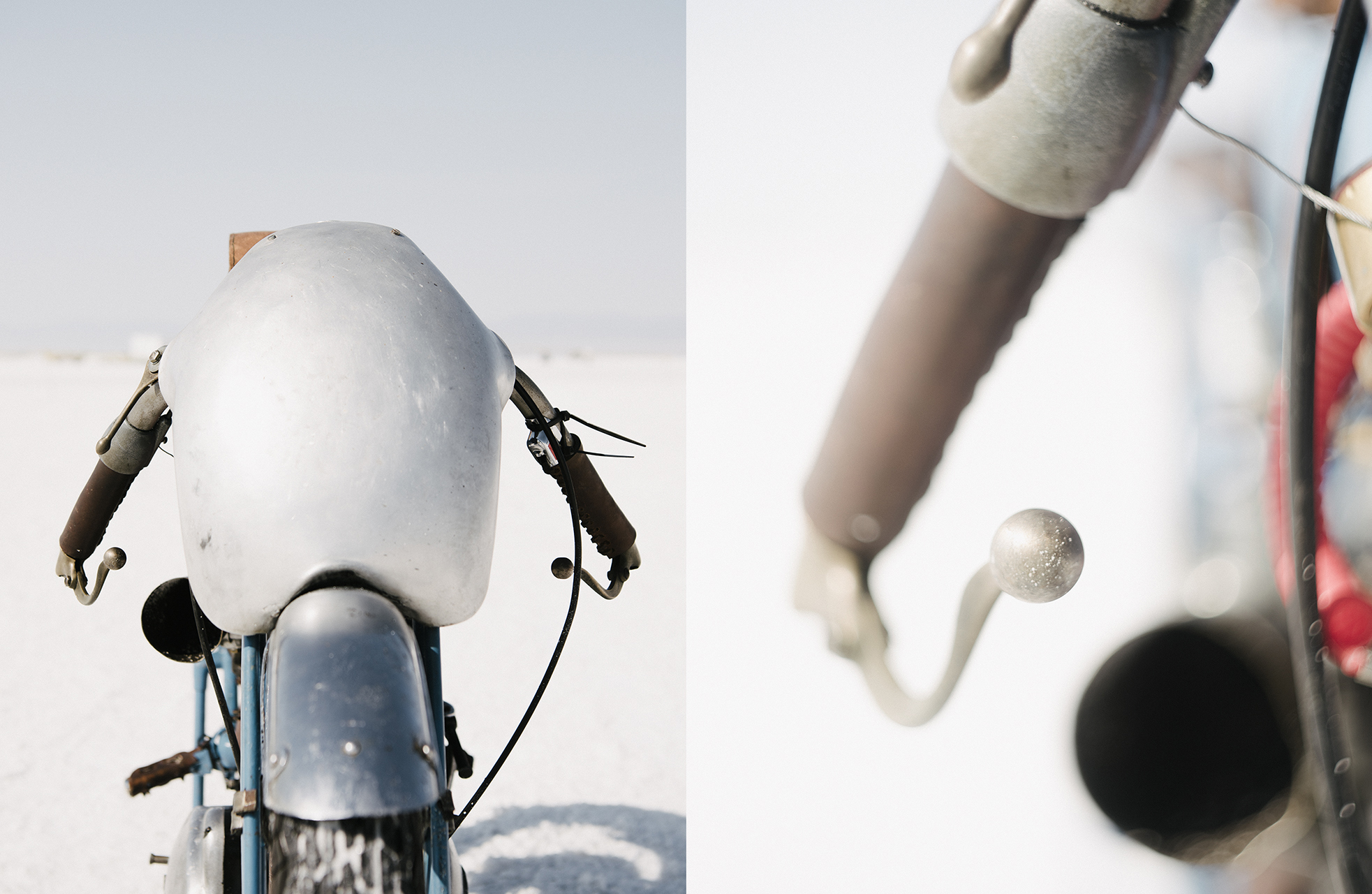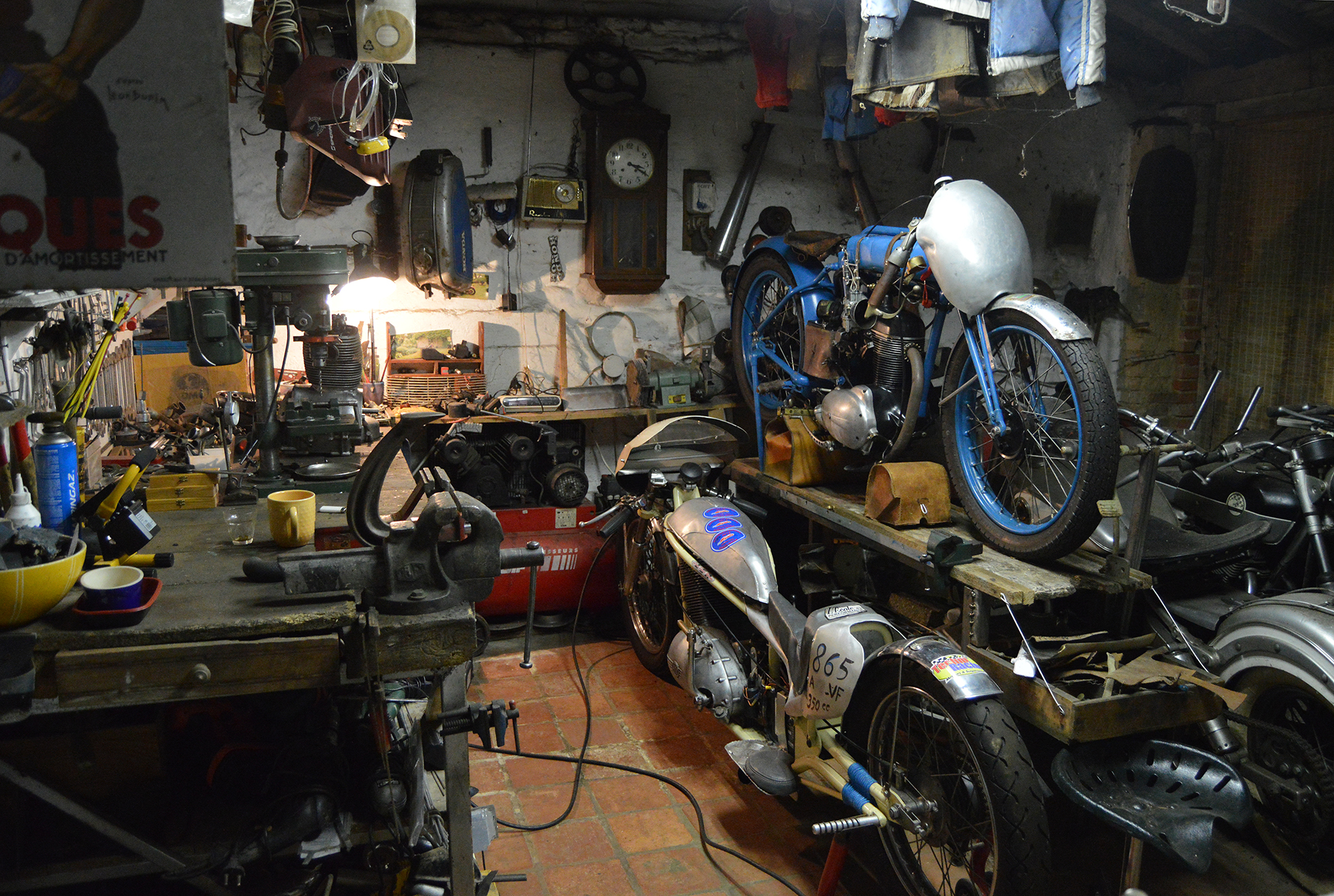Serge Campistron and his 175cc Motobecane, “Pyrene”
Text: Mike Blanchard • Photos: Saroyan Humphrey
Spotlight | When walking through the pits during Speed Week at Bonneville this year I came across a team with a beautiful little blue race bike I did not recognize. I asked around and met Serge Campistron who raced the bike. Turns out he made it as well.
Serge has dreamed of speed since he was a teenager. When he was 15 he built a 4CV Citroen based land speed racer.
“I fall in love with this place when I saw ‘Mechanics Popular’,” says Serge. “Before knowing what was a hot rod.” Since his teenage years he has gone on to gather up an impressive collection of vintage bikes and cars including a hot rod made from a 1928 B14 Citroen and a Harley knucklehead that he shares with three friends. They have made a deal to sell the bike if any of them has financial problems. However, “we swore never (to) loose this bike,” he says.
“My mother said ‘I hope you will not go so fast.’”
Serge explains few people in France know anything about racing at Bonneville. His family was mystified at first by his desire to build a land speed racer. It was not until seeing “The Worlds Fastest Indian” that they understood. “My mother said ‘I hope you will not go so fast,’” he says laughing. “For the moment she is right.”
He had just returned from the start line of the short course where the bike refused to run. He ran it in the pits before heading to the start and sitting in the pits now it starts right up. This is so typical of Bonneville. It is like witchcraft at times.
The name of the bike is Pyrene. “It’s the name I choose to paint on my hot rod,” Serge says. “I try to imagine two brothers in France in 1950. “Pierson and Reine” who prepared motorcycles. The phonetic contraction of the two names is Pyrene.”
The engine is a 175cc four stroke single from a 1954 Motobecane Z2c. The bike is supercharged using a brake assist vacuum pump from a French truck turned around and reengineered. The fuel tank is split in half with one half carrying fuel and the other half being packed with ice to keep the air fuel mixture cool. This is designed to eliminate an intercooler and keep the bike light. Serge made most of the frame as well. He started with a girder fork and head tube as well as a set of dropouts and lugs.
Serge started the project in 2004. “I decided to build this bike in my garage with no professional tools,” he says. “Just to know if I can build something in my box.”
Describing his garage as a little box is something of a misnomer. His shop is well equipped with a stand for the motorcycle and many tools. He loves repurposing everyday items (trash he calls it) and this is where artistry comes in. Not surprisingly Campistron, 51, is a painter and teaches art history at Samatan College in Gers but he is a little uneasy being called an artist. “I think artist is too big for one person,” he says.
“I decided to build this bike in my garage with no professional tools.”
The bike has a sense of whimsey about it in the details. The fairing is made from his wife’s wok. The velocity stack is made from an old trophy. The saddle comes from an old bicycle and the finger levers from household items. The grips are made of leather cut from his childhood school bag.
That is all neat but the goal is to set records and push your machine. And Serge has been successful. Since 2011 he has set records with Pyrene in his class. Pyrene runs in the APS/VF class which is specific to motorcycles and slightly separate from the normal SCTA (Southern California Timing Association) rules. It is a vintage pushrod class for bikes made before 1956. The F designation means the bike is running alcohol or nitromethane.
He has also set several records in the 250cc and 350cc vintage bike classes running AMC, Atelier Mecanique de Centre, engines in bikes of his own making.
The more I look at the motorcycle the more the color seems familiar. Serge says he was doing a painting of a Bugatti and mixing colors to get the correct shade. As he was mixing he realized that the shade was perfect for the bike. Bugatti blue, another spiritual connection to the great racing heritage of France.
Serge struggled with the bike this year. It took four days to find the problem after two ignition changes and much fiddling around with the carb. As it turned out three internal parts of the supercharger were overheating and causing the unit to lock up. The best he could do was 35 mph. Pyrene normally is good for 115 kph which translates to about 70mph.
“When I find the problem the engine was too damaged by heat and effort and became fragile,” says Serge. “I have (a) feel(ing) he will die so I let it die on the last run. The engine and the rear wheel stopped just in front of the panel and we both fell on the track. A not so bad end for a bike.”
Pyrene is an example of the old craft of reading the record and rule books and finding a niche in which to set a record. Some go to the salt to see how fast they can go in whatever will get them there. Some racers are in love with a specific class of cars or motorcycles (say something like a ’30s Ford lakes coupe or roaster). But many people are there for the engineering and personal challenge.
Serge started out with the off-hand idea of building a bike in his “box” to challenge the lords of speed. But it is the seductive dream that began when he was 15 that lures him back to the salt year after year.
Look for him in 2018 with a Peugeot 202 based race car.




